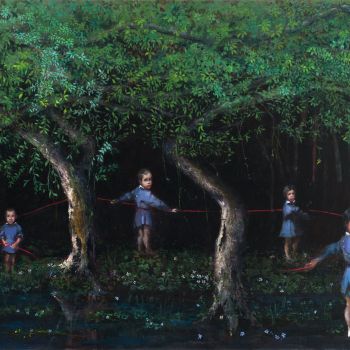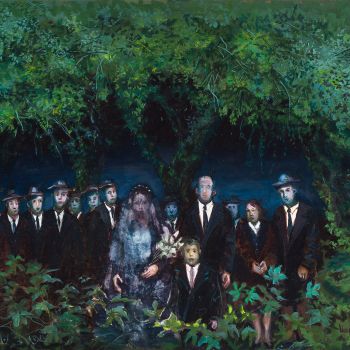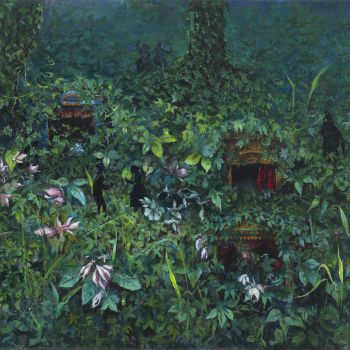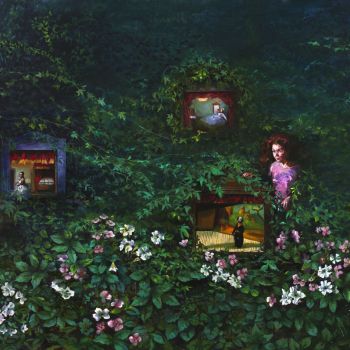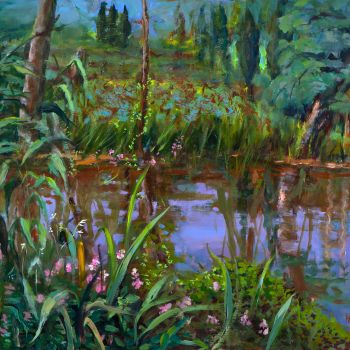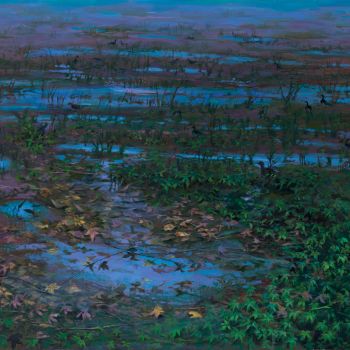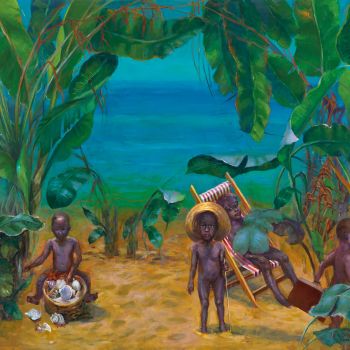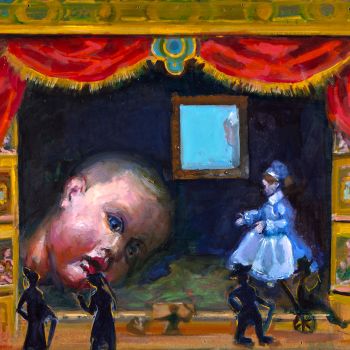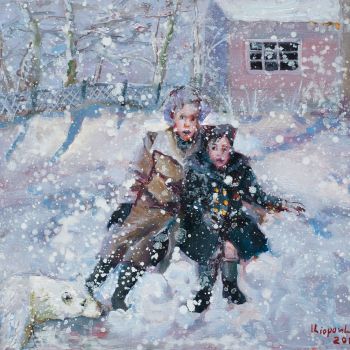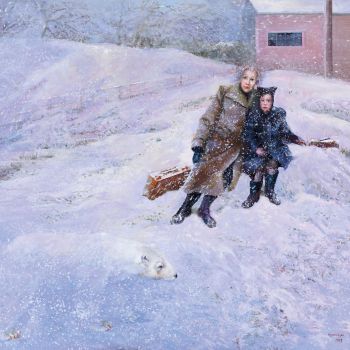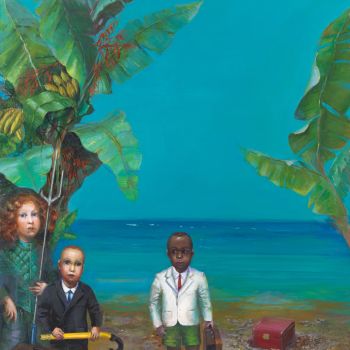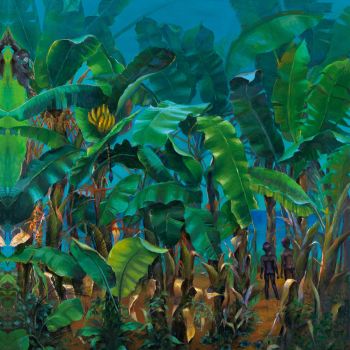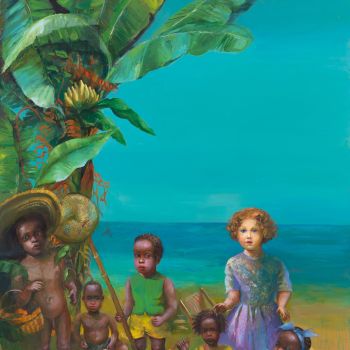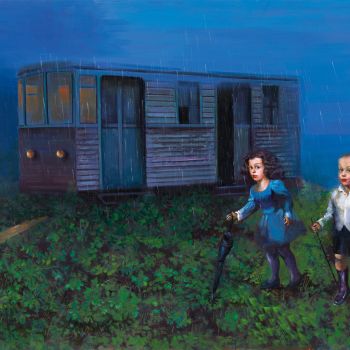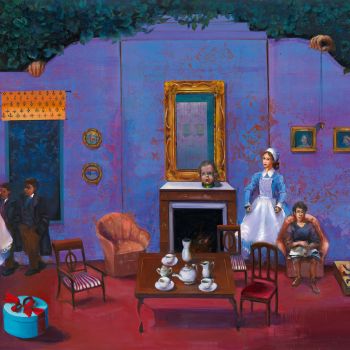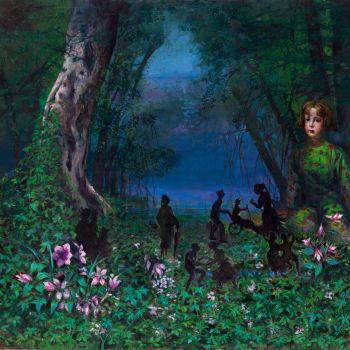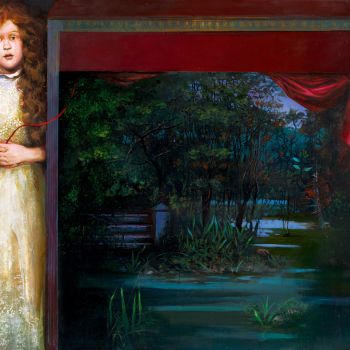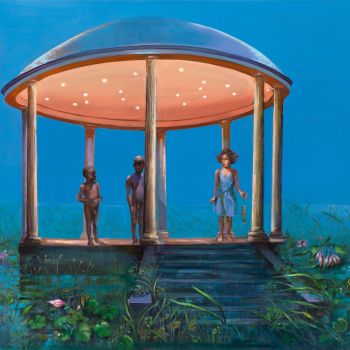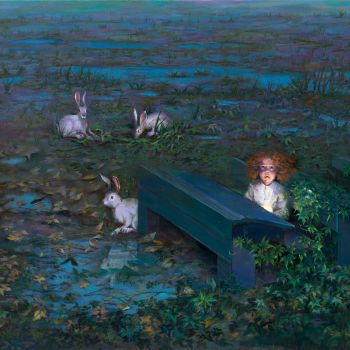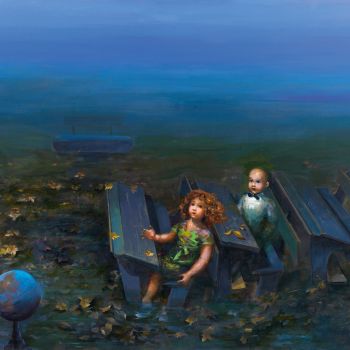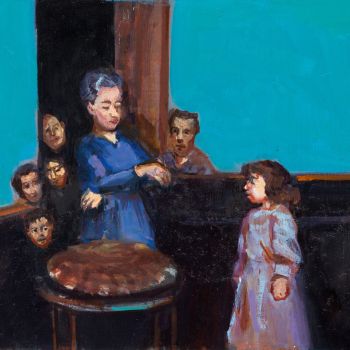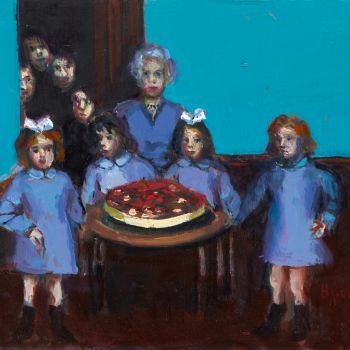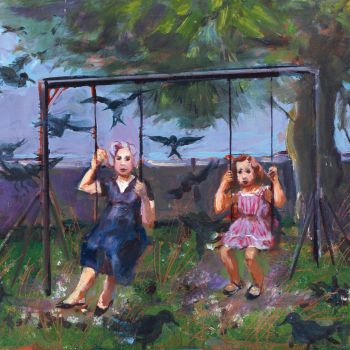Irini Iliopoulou's last show in Athens (2004) ended on a high note with balloons aloft, drifting by forest fairgrounds, ephebes and nymphettes astride runaway carousel ponies, cantering off into the sunset… something of a precursor to this present body of works. A surprise that's been several years in the making and kept secret until now. In this most personal exhibition, little children take center stage. Like a sequence of dreams, these new paintings explore childhood memories and fantasies that are at once intimate recollections and universal archetypes – Irini's fairy tales. Here the painter treats us to girlhood treasures – beloved trinkets and keepsakes taken out once more to play. In these works she delves into the unconscious, exploring the notion of 'screen memories' − how we remember, represent and even fabricate the stories of our past. Her recent paintings reflect the ambivalent nature of these remembrances, the deceptiveness of dreams and how the artist transcribes this nebulous state onto the canvas.
The pictures are riddled with allusions en abyme. The different paintings converse with one another via the reappearance of objects, props or personages (sometimes avatars of the artist herself). The way the works communicate and interconnect brings to mind a nursery rhyme sung in a round. Babes the dusky color of plums hold their own dark-skinned dolls on the beach of the Triptych, that turn up again in the architect's dollhouse, itself a miniature theatre. A putto head glimpsed in the boughs of the bitter orange trees also reappears on the mantel of the same dollhouse like a conversation piece. A red ribbon threads through the clasped hands of children, mysteriously held taut although their circle is broken. Red ribbons decorate oversized packages on the dollhouse set as well. The stunning little usher of the theatre painting pulls up the scarlet curtain with a red ribbon, revealing an enchanted vista of blue lagoon that is echoed elsewhere. The resurfacing of objects and elements, their passage from one painting to another, creates resonance – the unexpected being the keynote of Iliopoulou's lyricism.
As viewers, we are continually doing double takes, unsure of our own eyes. The mechanics of these dreamscapes hinges on a kind of surrealistic iconoclasm. It's not just insolence, her dismissing painterly protocol to exercise personal prerogative, but also her partiality for dramatic effect and scenography. In her work, Irini alludes to the fantastic underpinnings of the dreamworld : castaway boys in jackets and neckties, sporting briefcase and snorkel, girl with trident overdressed for the tropics. Articles discovered ashore after a storm? A naked child seated before a basket of conches like a shaman's talismans. Maybe the red case is a treasure trove, the suitcase holds a pirate's plunder?
The dream of racial equality, the celebration of cultural diversity with a hint of 'colonial camp' (primly dressed little schoolmistress surrounded by her black charges, both 'native' and 'civilized') is offset in the partner piece by the arrival of the little black executive, wielding briefcase and pen. The props accentuate the humor of the double entendres implicit in these scenes of mingling on the beach and poke fun at images of Edenic escapes for tourists.
Blue is the dominant hue in these works, while at other times Irini has favored red in her palette. Ethereal aqua sky merging with turquoise sea, the ultramarine of shore is bordered by banana trees, their luxurious jade leaves wafting lazily in an almost airless space – fanning and shading the lounging boy with languorous eyes. Banana trees dwarf the proverbial 'pygmies' padding through the forests of treasure isles, complete with a chimp in the eaves. The tropical seascape is steamy and static lined with brown sugar sand that's temptingly touchable. Indolent heat permeates and abates danger. On this desert island there are no signs of a boat, adult deliverance or struggle of any sort– be it to survive, weather the elements or ward off attacks at the hands of a mutinous crew or indigenes. Against the azure backdrop, the little teacher stands transfixed. The children are entranced, silent so as to catch the strains of sirens. Too intent on their play to be marooned. Elsewhere unattended children wearing periwinkle uniforms are linked by a red ribbon in the waning afternoon light, blue shadow cast on the serpentine branches overhead. In these tableaux that evoke magic realism, the children are subdued and demure but venture off unescorted, as in all fairy tales. They look out beyond us somewhat distrustfully, or surprised as if caught in an act of transgression.
Iliopoulou doesn't ply herself to rendering likeness but applies her art to evocation which, according to the artist's creed, should remain morphologically inexplicit. As such, the fullness, sanguine ripeness and vulnerability – the as yet unspoiled countenance of childhood lends itself to a more liberal, and not literal, interpretation of physiognomy. Children are depicted with a whimsy and tenderness that hyperrealist figuration prohibits. In a sense, Irini both idealizes and idolizes childhood as she fixes forever the innocence and vibrancy of first youth in figures that are somewhat stylized or poised. The delectation with which Iliopoulou previously painted pastries and farmers' market produce has been transferred to children here, where appetite infuses her renderings of plump cheeks, rosy lips, halos of hair, frilly dresses…
Familiar from other phases in Irini's trajectory as an artist, the vegetal world is again as eccentric as any creature of her own invention. In these fantastical paintings, nature is at her most fecund – sodden, overlaid. Barefoot children stand ankle-deep or waist-high in water. Trees hover over the rising water and electric indigo glows in the background. We're drawn into a funneling blue vortex – inducing a soothing trance, amniotic submergence. For the moment, all is placid in these wilderness scenes but there could be something lurking in the twilit forest. Nature protects the unaccompanied minors, canopying their clandestine gatherings, sheltering them during their nocturnal fugues. In fairy tales involving flight or escape, children are often befriended by woodland animals, beguiled by trolls and guided by nature. Thus the woods and hills (and beach) are the protagonists' playground, the scene of endless hunts and pursuits.
A threesome forms a ring around bitter orange trees bearing blue fruit in the moonlight. A blue fog settles in on the children playing school, seated in a row of classroom benches like travelers ready to float away. There's a globe rather than a teacher at the helm. Autumn leaves drift over desktops and are strewn across the water at their feet. Now a little sprite of a child sits alone with a lantern illuminating a mystified expression. Or is it a magic globe with which she's conjured up the fabled hares? Was she one of them just moments before the spell was cast – as suggests the hare reflected in the pool of water beside her? There is a lyrical gamut of blue and mauve refracted by the white fur and starched blouse, then trails of fern crawling up to rescue the child from the rising tide. In another painting, a girl's pyjamas blend with the tangle of ivy beneath her, as if Beatrice herself had sprouted up from the ground. Her porcelain doll's face is belied by a typically childlike posture. In a fairy ring before her, stencil puppets acquire a third dimension as golden light contours their silhouettes against an endless cerulean backdrop. A colonnade of trees bow out to create a clearing for the shadow theatre. A magical performance witnessed by a tree with a face hollowed in its trunk, that's home to a mass of ivy that mirrors the shape of the girl opposite.
The provocative beauty of the theatre girl with parted lips is accentuated by her opalescent gown of taffeta and embroidered lace. It contrasts dramatically with the perspective of velvety blue lagoons contained within the theatre box with its ornate trim. Her candor and purity beckons us in : a decadent red satin curtain gathered up opposite her lustrous dress, how her open oblong face is extravagantly framed by cascades of auburn hair and how her gown is fit for a child bride − are all suggestive of a latent eroticism. In the painting of the dollhouse, a puppeteer's hand dangles an architect's plumb line between portraits hung symmetrically on a partition wall of the parlor. The adjacent fold also reveals a hand drawing attention to the frame below – a deep-sea blue view of the outdoors, or a decorative painting? The dainty pinafored maids juxtapose with the prosaic lady in repose. The boys in Victorian frock coats lunge in unison toward some attraction offstage. An iridescent magenta seems to be seeping through the stenciled wallpaper; the prodigious presents make the furniture look fragile and the tea service like a toy. The gilded frame on the mantelpiece reflects another companion set of pictures, while the parlor stage seems ensconced in teal blue foliage.
A girl with fiery wings of hair wades out into a lagoon following her guide and the ripples fanning out in the turtle's wake like vapors. The emerald and aquamarines of the 'bush' stand out against her exotic pallor. She returns with her catch and aubergine-colored companions in the dome painting, a star-studded gazebo that resembles a flying saucer that just alighted in the marsh. A mysterious train wagon is parked in an empty field, ferns growing over the rails while beacon headlights guide the children in out of the rain. The girl's umbrella stays closed while her friend, crop in hand, seems to enjoy the shower in his wellington boots.
This body of works results from a period of long introspection, a journey back to imagination's first articulations, in child's play like dress up, pretend, chase, circle games… In these reveries, Iliopoulou poignantly paints children on their own – escapades where parents are left behind. Eventually our elders leave us. What we hold after their loss is our longing to be revisited by memories − to sense the presence of the departed again. Irini Iliopoulou returns to childhood enchantments because they are stories that when finished take us home. The absence of adults in these pictures implies they are waiting at the end of the adventure. Irini imagines the interval of evasion with abandon – children explore the coastline, venture into the forest, all with a palpable sense of purpose, perhaps one that defiance requires. Something the artist shares with her subject and dares us: the temerity of innocents.
Andrea Schroth
September 2009


